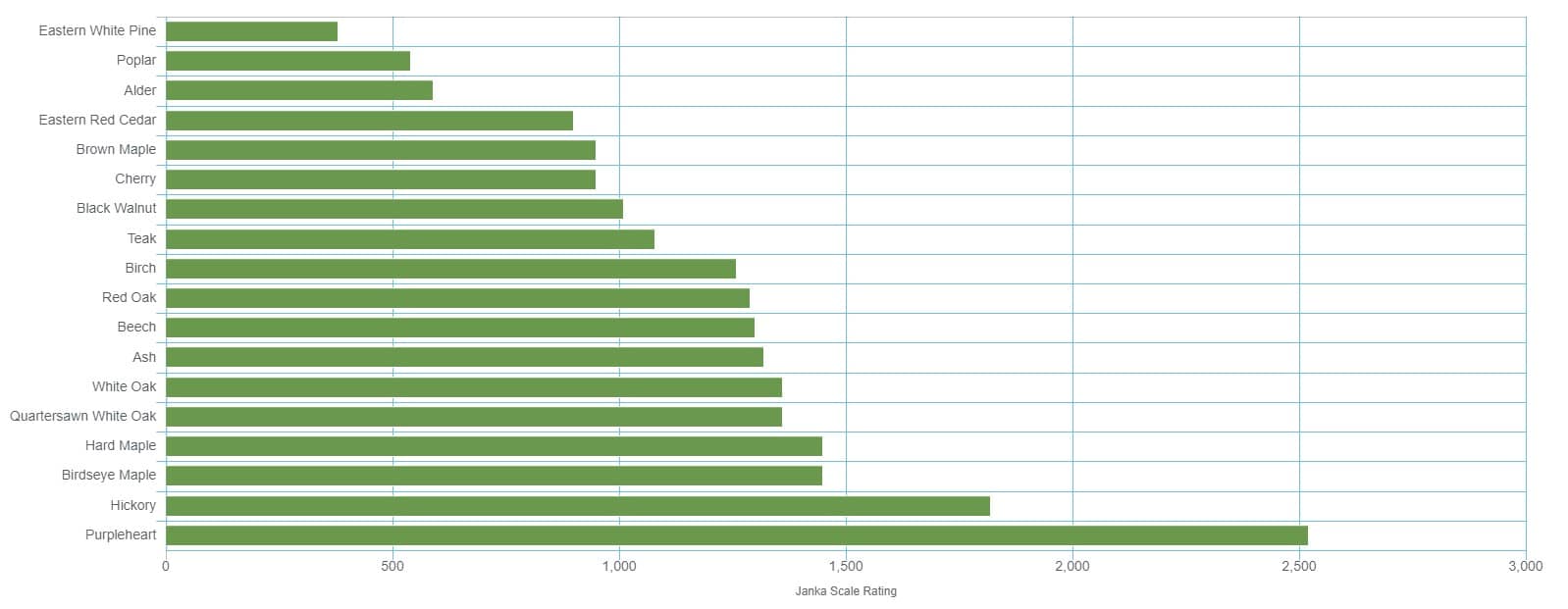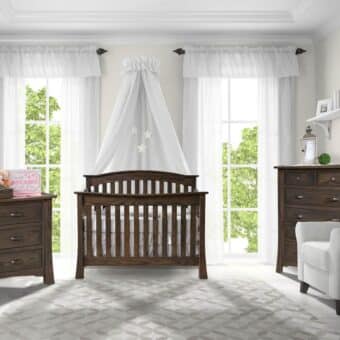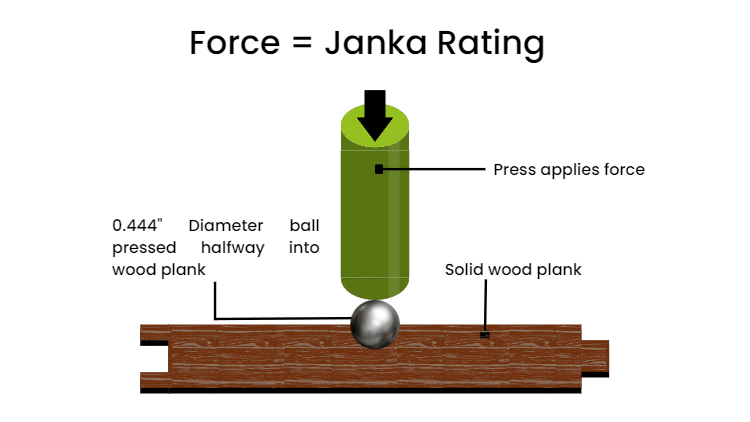The Janka wood hardness scale is widely recognized as the industry standard for assessing the durability of wood materials. This information is critical in helping carpenters and other professionals identify the optimal wood species for specific applications. Through the use of this scale, experts can easily pinpoint which wood types have the necessary hardness to withstand wear and tear, as well as which ones will be easy to manipulate with common tools. Such knowledge is especially essential for vital components of a house, such as furniture, which you'll want the best quality to ensure a lifetime of use. Choosing wood products can be an environmentally-friendly decision as they store carbon emissions.
The Janka wood hardness scale lists the hardness of wood species where the highest ranking makes up the hardest woods.
Janka Hardness Scale Chart
The method to determine the wood hardness scale involves measuring the force necessary to insert a .444-inch steel ball up to half of its diameter within a wooden material.
Wood hardness can be assessed by taking into account various factors, one of which being the Janka hardness scale. However, it is important to bear in mind that even species ranked highly on this scale are not immune to damage from sharp or heavy objects.
As such, it is recommended to use the scale as a general guide to identify durable woods, but also to implement proper maintenance routines to avoid premature wear and tear.
The Janka hardness test is a standard method to determine the relative hardness of wood. The test utilizes a 2" x 2" x 6" sample of wood and a 0.444" steel ball. By applying force and pressing the steel ball halfway into the wood, the hardness of the wood is determined.
The measurement taken is in pounds per square inch, which in turn is used to rate the wood on the Janka hardness scale. A higher rating indicates a harder wood, and the scale's maximum rating is 4000.
Below is a chart demonstrating the Janka rating of common woods you can find in furniture, flooring, and more:

Most Amish made furniture is made out of the following hardwoods:
- Brown Maple
- Cherry
- Black Walnut
- Red Oak
- Quartersawn White Oak
- Hard Maple
- Hickory
If we use the Janka Scale we can help determine what wood might be best for the type of furniture you're looking to get. While woods like Hard Maple and Hickory rate higher that doesn't necessarily mean they're the best choice for specific types of furniture. Be sure to read the Janka Scale facts for more information.
Janka Hardness Scale Facts
Below are a set of interesting facts regarding the Janka hardness rating system.
The Harder the Wood, the Higher the Rating
It is important to bear in mind that the Janka hardness scale rates wood species based on their relative hardness, with those having higher ratings being the hardest. When selecting wood for your furniture needs, it is advisable to go for those with high ratings on the scale as they are more fitting for furniture purposes.
Nonetheless, it should be noted that other variables come into play when considering the best wood for woodworking based on its practicality. If you opt for wood species with low ratings on the scale, they might not have the requisite durability and strength to support heavy traffic. Therefore, it is crucial to consider not just the Janka scale but other factors when selecting the best wood for your woodworking project.
If the Wood has Grain Makes an Impact
Wood grain plays a significant role in the accuracy of test results. The outcome of tests will vary depending on the type of grain used. The industry standard is the flat grain, which produces results that are reflected on the Janka hardness scale. Although vertical wood grain results cannot be measured on the scale, they are still taken into account when testing different wood species using the Janka hardness test. Additional tests are performed on the ends and the sides, but their results are also not included on the hardness scale as they differ from the flat grain. Therefore, it is important to note that the results on the Janka wood hardness scale are exclusively from the flat grain of the wood that is being tested.
The Scale goes from 0 to 4,000
The Janka hardness scale is a reliable indicator of how hard and strong a piece of wood can be. While there is no wood with a lowest rating of 0, the closer a rating is to 0, the more susceptible it is to dents and scratches. Wood ratings vary between 0 and 4000, making it easy to determine the strength and suitability of materials for various applications.
While wood with a rating of 4000 is incredibly strong and durable, it may not always be ideal for furniture due to its density. This makes it challenging to use a saw or drill when working with it. High densensity can incur humidity related issues as well. It is important to consider all factors when choosing a wood type to ensure that the material is both suitable for the intended application and easy to work with.
Janka Rating Will be Dependent on How the Wood Will be Used
While harder woods offer better scratch resistance, proper care is crucial. Even when using the hardest wood, the wood can still dent and scratch over time. Factors such as excessive traffic, poor maintenance, and lack of protection from heavy objects can significantly impact the wood. However, the hardness scale can guide you on the type of wood to use for your furniture needs.
For instance, it is not recommended to use Eastern White Pine wood for a kitchen table, with a rating of 380, which is relatively low. On the other hand, woods with ratings above 1000 will serve aptly for most kitchen table needs.

![Carlston Amish Bedroom Set [Sap Cherry with a Mineral finish]](https://eadn-wc01-1253085.nxedge.io/wp-content/uploads/2022/07/Carlston-Mineral-340x340.jpg)

![Malaya Amish Collection [Chair, Sofa, and Coffee Table]](https://eadn-wc01-1253085.nxedge.io/wp-content/uploads/2022/09/Malaya-Setting-IDB-150x150.jpg)

